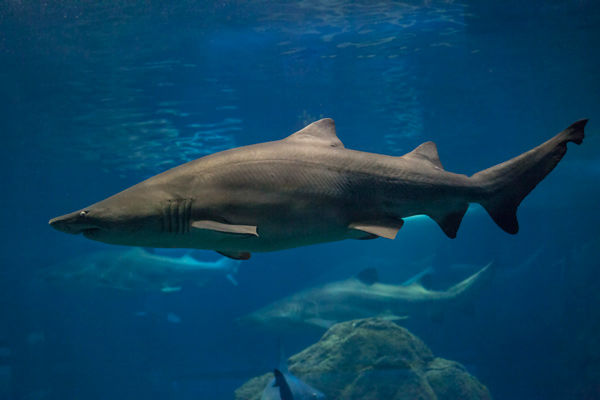Shark Week 2014 Facts & Photos






PHILADELPHIA (WPVI) -- While there might not be any Sharknadoes in the forecast, it is Shark Week.
Whether you are watching documentaries on television or visiting the Shark Week Live! exhibit at the Adventure Aquarium, you'll need to know a few things about the often misunderstood fish to impress your friends.
So study these facts, courtesy of the Adventure Aquarium, and give your Shark Week conversations more bite!
How many species of sharks are there?
Currently there are approximately 400 described species of sharks, however, new species are being discovered all the time.
Fossil records indicate that ancestors of modern sharks swam the seas over 400 million years ago, making them older than dinosaurs!
Elasmobranchs (which include sharks, rays, and skates) are a closely related group of fishes, differing from bony fishes by having cartilaginous skeletons and five or more gill slits on each side of the head. In contrast, bony fishes have bony skeletons and a single gill cover.
How many teeth do sharks have?
Sharks have lots of teeth arranged in layers so if any break off, new sharp teeth can immediately take their place. Sharks can shed thousands of teeth during their life, and this is why sharks teeth can be found washed onto beaches. Shark teeth also fossilize easily while the rest of the shark decomposes.
What does shark skin feel like?
Shark skin feels exactly like sandpaper because it is made up of tiny teeth-like structures called placoid scales, also known as dermal denticles.
These scales point towards the tail and help to reduce friction from surrounding water when the shark swims. Because of this, if someone rubbed the skin from the head towards the tail, it would feel very smooth.
In the opposite direction it feels very rough like sandpaper. As the shark grows, the placoid scales do not increase in size, but rather the shark grows more scales. The silky shark (Carcharhinus falciformis) has small scales giving it a "silky" feel to the touch.
How long do sharks live?
While longevity data are not available for many sharks, maximum ages do vary by species. Some sharks like the smooth dogfish (Mustelus canis) may only live 16 years, while others such as the porbeagle shark, (Lamna nasus) may live as long as 46 years. Whale sharks (Rhincodon typus) the largest fish in the world may live over 100 years.
Do sharks need to swim all the time?
While some species of sharks do need to swim constantly, this is not true for all sharks. Some sharks such as the nurse shark have spiracles that force water across their gills allowing for stationary rest. Sharks do not sleep like humans do, but instead have active and restful periods.
How well do sharks see?
Sharks have the ability to open and close the pupil in response to differing light situations similar to humans while most fish do not possess this ability. A shark's eye also includes a cornea, iris, lens, and retina. Rods and cones are located in the shark's retina, allowing the shark to see in differing light situations as well as to see color and detail.
In addition, sharks, similar to cats, have a mirror-like layer in the back of the eye referred to as the tapetum lucidum. This layer further increases the intensity of incoming light, enhancing the eye's sensitivity to light.
Although it was once thought that sharks had very poor vision, we now know that sharks have sharp vision. Research has shown that sharks may be more than 10x as sensitive to light as humans. Scientists also believe that sharks may be far-sighted, able to see better at distance rather than close-up, due to the structure of the eye. Vision varies among species of sharks due to differences in the size, focusing ability, and strength of the eyes.
Shark Myths Debunked
Sharks can smell a single drop of blood in the ocean: FALSE.
- Sharks may have great senses, but a shark's sense of smell is often highly exaggerated in film and media.
Sharks need to eat all the time: FALSE
- Sharks at Adventure Aquarium are fed 6 out 7 days a week.
- In the wild, sharks are opportunist eaters. They eat when they find food.
- On average, sharks eat a bit less than 2% of their body weight. This is slightly less than humans.
- Great White Sharks can go up to three months without eating by living off oil stored in their liver.
Sharks aren't very smart: FALSE
- Sharks have some of the largest brains among all fish, with brain-to-body ratios similar to mammals and birds.
- Sharks are even capable of learning a conditioned response faster than a cat or rabbit. AAQ's sharks are conditioned (trained) to eat at a certain area of the exhibit.
Adventure Aquarium is home to the largest collection of sharks on the East Coast and the only aquarium in the U.S. with a Great Hammerhead Shark on exhibit.
For more information on Adventure Aquarium's Shark Week Live August 9-17, visit Adventureaquarium.com





